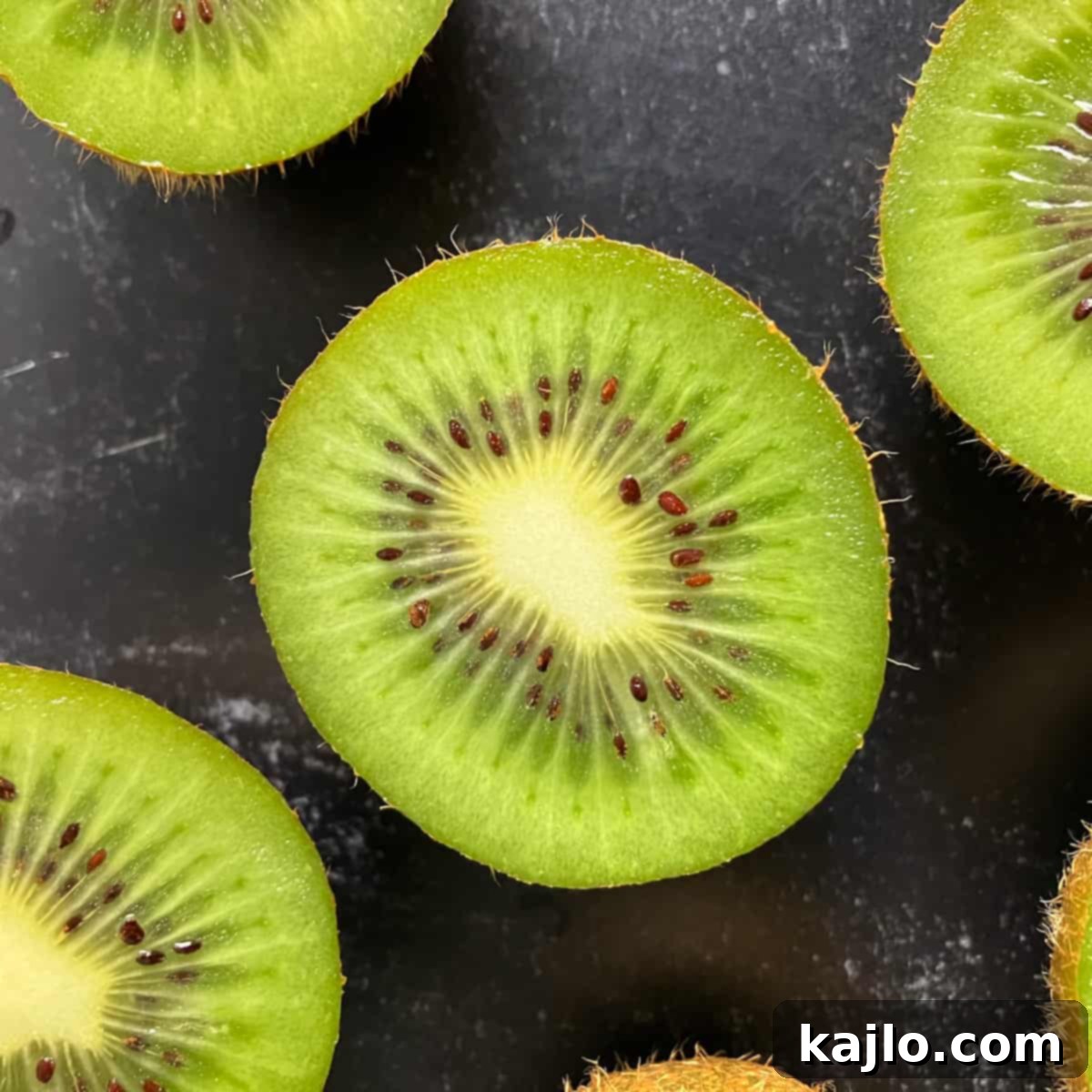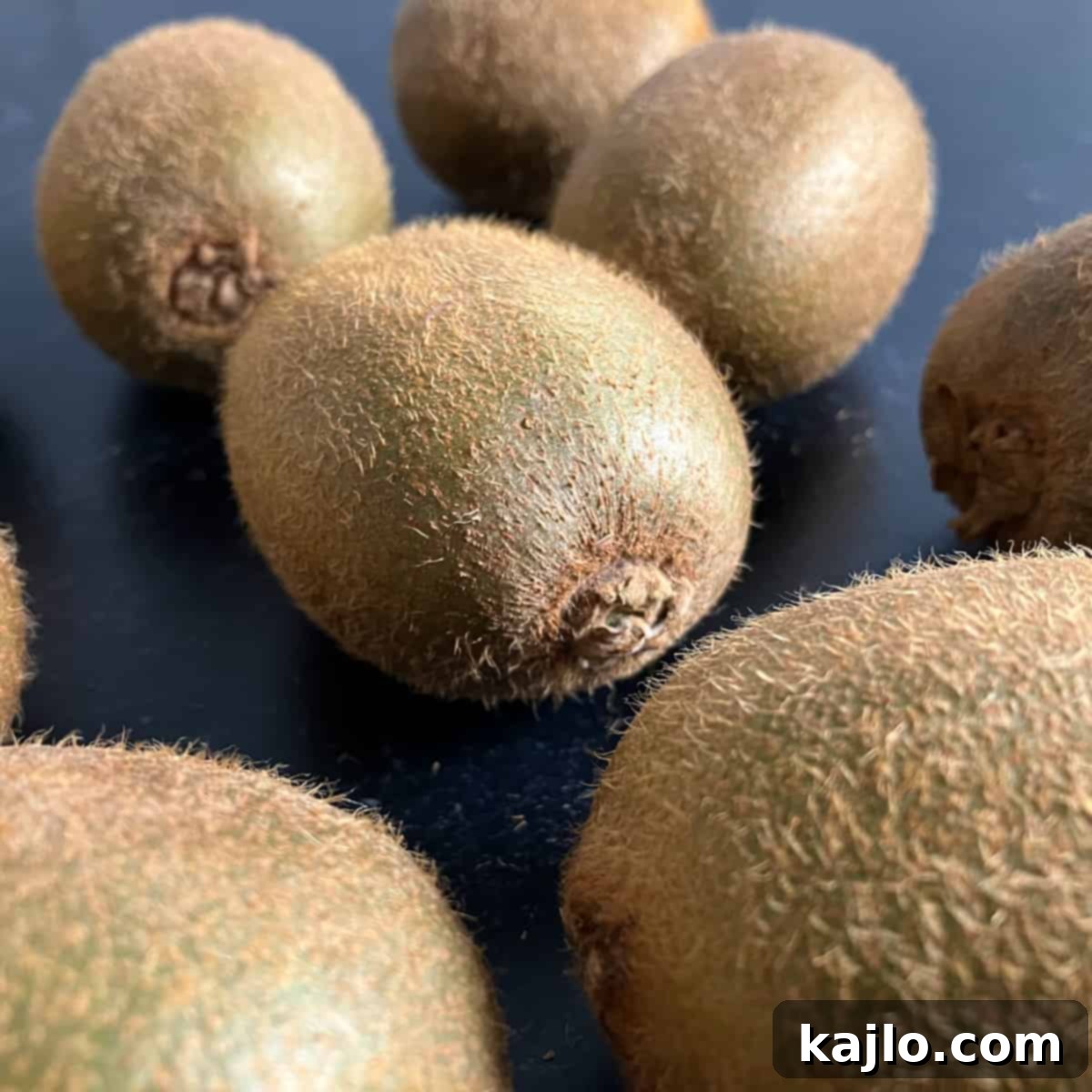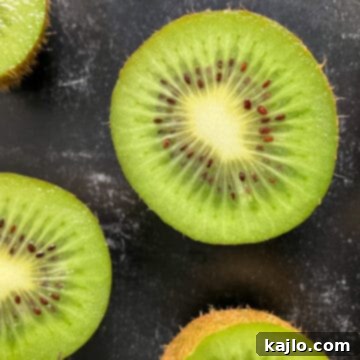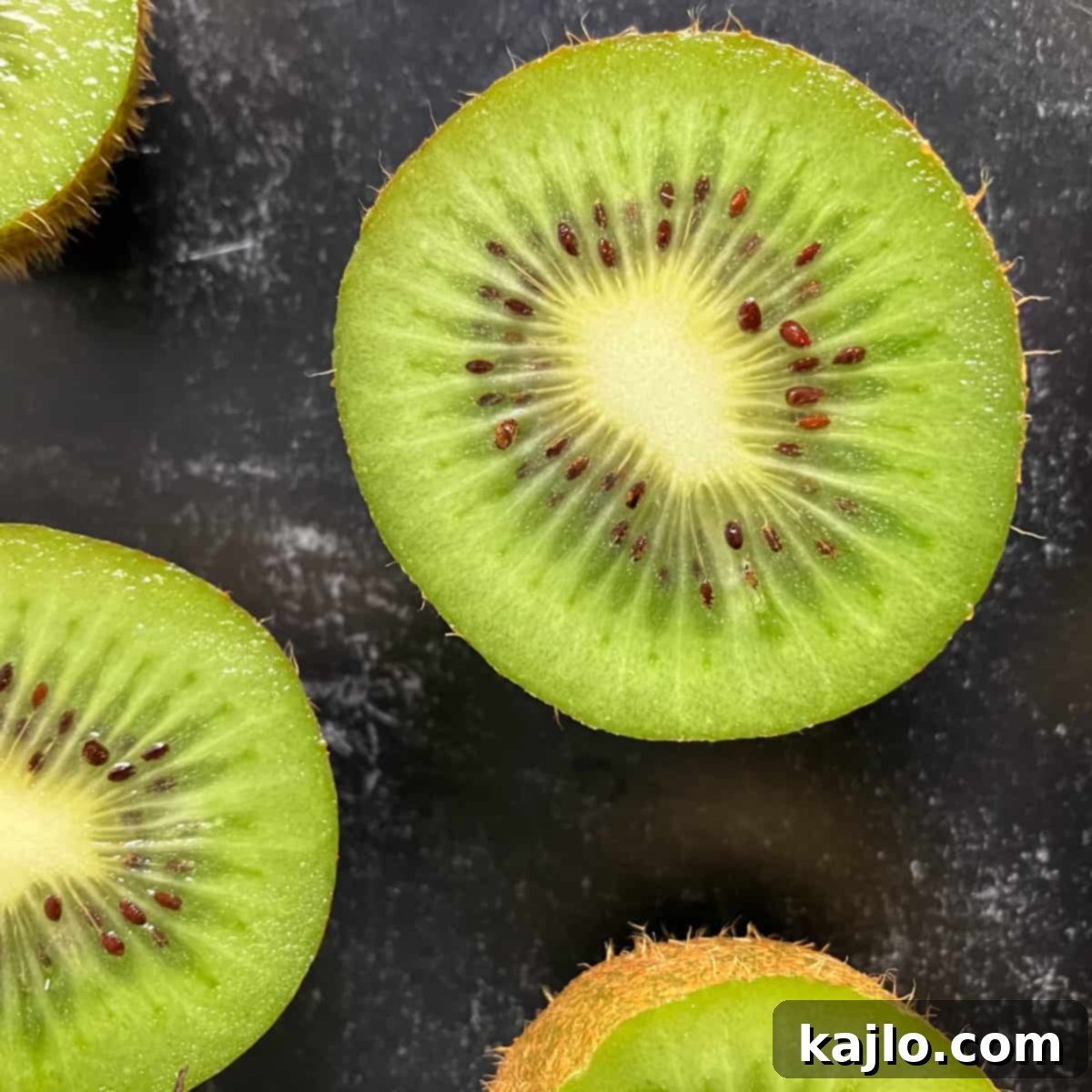Is Kiwi a Citrus Fruit? Unpacking the Truth About This Popular Berry
The delicious and vibrant kiwi fruit often sparks a common question: is kiwi a citrus fruit? Despite its tangy flavor and impressive vitamin C content, many are surprised to learn that the answer is definitively no. Kiwifruit, also known as the Chinese gooseberry, is actually classified as a true berry. This comprehensive guide will delve into the botanical distinctions, nutritional profile, and other fascinating facts about kiwi, while also providing a clear list of citrus fruits like lemon, orange, and lime, and a list of non-citrus fruits such as strawberry, mango, and papaya. We’ll also explore the acidity of kiwi and discuss its suitability for individuals managing acid reflux.

🥝 Is Kiwi a Citrus Fruit? A Definitive Answer
Are kiwis citrus? To clarify once and for all, no, a kiwi is not a citrus fruit. While kiwis possess a refreshing tartness and are packed with vitamin C—qualities often associated with citrus—they belong to an entirely different botanical family. Kiwifruit is botanically categorized as a true berry, stemming from a single flower with one ovary. This classification places it alongside fruits like grapes and bananas, rather than oranges or lemons.
While both kiwis and citrus fruits are renowned for being nutrient-dense powerhouses, rich in vitamin C and antioxidants that bolster the immune system, their botanical origins and characteristics set them apart in various fundamental ways. Understanding these differences helps to demystify why kiwi isn’t considered citrus:
- Botanical Family: Citrus fruits, which include well-known varieties like oranges, lemons, grapefruits, and limes, are members of the Rutaceae family, specifically falling under the Citrus genus. Kiwifruits, on the other hand, are part of the Actinidiaceae family, belonging to the genus Actinidia. This fundamental distinction in botanical classification is the primary reason they are not grouped together.
- Growth Habit: Citrus trees typically grow as shrubs or small to medium-sized evergreen trees. Kiwifruits, however, grow on robust, woody vines, much like grapes. This difference in how they grow is a clear indicator of their distinct botanical identities.
- Skin and Peel: A defining characteristic of citrus fruits is their leathery, aromatic rind, which is typically thick and not consumed directly (though it can be zested or candied). Kiwis, conversely, have a thin, fuzzy brown skin that is entirely edible, though many prefer to peel it for texture or personal preference. The internal structure also differs significantly; citrus fruits are segmented with juice-filled vesicles, whereas kiwis have a solid, often bright green or gold flesh dotted with tiny, edible black seeds.
- Acidity Profile: While kiwis do have an acidic taste, the specific types and concentrations of acids differ from those found in citrus fruits. Citrus fruits are particularly rich in citric acid, which gives them their characteristic sharp tang. Kiwis contain a combination of citric acid, malic acid, and quinic acid, contributing to a slightly different acidic profile and overall flavor experience.

Is Gold Kiwi a Citrus Fruit?
When considering different varieties, the question often arises: is golden kiwi a citrus fruit? The answer remains consistent: no. None of the delightful varieties of kiwi, including the sweeter and often less acidic gold kiwi (also known as Zespri SunGold kiwi), are classified as citrus fruits. Despite its unique flavor profile, which can be less tart than its green counterpart, the gold kiwi shares the same botanical classification as a berry.
➕ Is Kiwi a Tropical Fruit?
While kiwis thrive in warmer climates and sometimes share characteristics with tropical fruits, they are not typically classified as such. The distinction primarily lies in their geographic origin and the specific climatic conditions of their main cultivation regions. The kiwi plant is native to mainland China and Taiwan, areas that are predominantly temperate or subtropical rather than strictly tropical. Although commercial cultivation has spread globally to regions like New Zealand, California, and Italy, these areas also largely possess subtropical or temperate climates, characterized by distinct seasons, including cooler winters.
Tropical fruits, by definition, are those that originate and primarily grow in equatorial regions, thriving in consistently warm, humid climates without significant seasonal temperature fluctuations. While kiwi enjoys warmth, its ability to tolerate cooler periods and its historical origins differentiate it from true tropical fruits such as mangoes, pineapples, or papayas.
🔥 Is Kiwi Good for Acid Reflux?
The suitability of kiwi for individuals with acid reflux can vary greatly from person to person. Kiwi is indeed an acidic fruit, and for some, acidic foods can trigger or worsen acid reflux symptoms. However, many individuals find that they can tolerate kiwi without discomfort, especially the less acidic golden varieties. It truly “depends” on your personal tolerance.
Managing acid reflux effectively requires paying close attention to your body’s unique responses to different foods. What might be a trigger for one person could be perfectly fine for another. For those diagnosed with gastroesophageal reflux disease (GERD), it is particularly important to identify and avoid specific food triggers. The Academy of Nutrition and Dietetics emphasizes that the fruits and vegetables that cause symptoms in GERD patients are highly individual. Therefore, while kiwi offers numerous health benefits, it’s always best to consult with your healthcare provider or a registered dietitian for personalized dietary advice, especially if you have chronic acid reflux or GERD.
Is Kiwi Acidic?
Yes, kiwi is an acidic fruit. Its pH level typically ranges from 3.1 to 3.9, placing it firmly on the acidic side of the pH scale. The exact acidity can vary based on the specific type of kiwi; for instance, green kiwis generally exhibit higher acidity compared to the sweeter golden kiwi varieties. The distinct tartness of kiwi is attributed to its rich content of various organic acids, including citric acid, malic acid, and quinic acid, all of which collectively contribute to its relatively low pH.
Is Kiwi More Acidic Than Oranges?
When comparing the acidity of kiwi to that of oranges, they often fall into a similar range, though this can depend on the specific variety and ripeness of each fruit. Oranges are widely recognized for their high levels of citric acid, with pH values typically ranging from 3.0 to 4.0. Kiwis, as mentioned, have a pH between 3.1 and 3.9. This means that while some kiwi varieties might be slightly less acidic than a very tart orange, their overall acidity levels are quite comparable. Consequently, if oranges trigger acid reflux symptoms for you, kiwis might also, although individual reactions can differ significantly.
🍋 List of Citrus Fruits
Citrus fruits are known for their distinctive aroma, segmented flesh, and often tart flavor. They are a staple in diets worldwide, celebrated for their high vitamin C content and antioxidant properties. Here is a comprehensive list of common and some lesser-known citrus fruits:
- Oranges: Perhaps the most iconic citrus fruit, known for its sweet-tart juice and versatile uses.
- Lemons: Highly acidic and intensely flavored, indispensable in cooking and beverages.
- Limes: Similar to lemons but with a distinct, often more floral or bitter flavor, popular in tropical cuisines.
- Grapefruits: Large, typically tart to bittersweet, and known for their vibrant pink, red, or yellow flesh.
- Mandarins (Mandarin Oranges): A group of smaller, sweeter, and easier-to-peel oranges, including:
- Tangerines: A specific type of mandarin with a deeper orange color and a slightly sweeter flavor.
- Clementines: Small, seedless, and very easy to peel, making them popular snacks.
- Pomelos: The largest citrus fruit, with a thick rind and sweet, mild-flavored flesh, often less acidic than grapefruit.
- Citrons: An ancient citrus fruit, primarily grown for its thick rind, which is often candied or used for zest.
- Buddha’s Hand: A unique citron variety with finger-like segments, valued for its aromatic zest rather than juice or pulp.
- Kumquats: Small, olive-sized citrus fruits that are eaten whole, including the sweet rind and tart pulp.
- Blood Orange: A distinctive orange variety characterized by its deep red, almost maroon flesh, due to the presence of anthocyanins. It offers a unique flavor profile, often described as a mix of orange with hints of raspberry or cranberry.
🍋 Is Lemon a Citrus Fruit?
Yes, lemon is unequivocally a citrus fruit. It is one of the most widely recognized members of the Citrus genus, prized globally for its sharp, sour taste and high vitamin C content.
🍓 List of Non-Citrus Fruits
Understanding which fruits are not citrus can be just as important as knowing which ones are. Many fruits share some characteristics with citrus, such as sweetness, tartness, or high vitamin C, but belong to different botanical families. Here is an extensive (though non-exhaustive) list of non-citrus fruits:
- Apples: Pome fruits from the Rosaceae family, known for their crisp texture and diverse flavors.
- Pears: Also pome fruits, closely related to apples, with a sweet, grainy flesh.
- Bananas: Tropical berries (botanically speaking) from the Musaceae family, famous for their creamy texture and high potassium content.
- Grapes: True berries, grown on vines, available in numerous varieties and colors.
- Berries: This category encompasses many small, fleshy fruits that are botanically classified as berries (like blueberries) or aggregate fruits (like raspberries and blackberries).
- Raspberries
- Strawberries (an aggregate accessory fruit)
- Blueberries (true berries)
- Blackberries (an aggregate fruit)
- Cherries: Stone fruits (drupes) from the Rosaceae family, known for their sweet or tart taste and firm flesh.
- Kiwifruits: As established, these are berries from the Actinidiaceae family.
- Mangoes: Tropical stone fruits (drupes) from the Anacardiaceae family, celebrated for their sweet, aromatic flesh.
- Papaya: A tropical fruit from the Caricaceae family, known for its sweet, musky flavor and soft flesh.
- Pineapples: A composite fruit from the Bromeliaceae family, famous for its juicy, sweet-tart taste and fibrous flesh.
- Apricots: Small, fuzzy stone fruits, related to peaches, offering a sweet-tart flavor.
- Plums: Drupes from the Rosaceae family, diverse in color and sweetness.
- Peaches: Large, juicy stone fruits with fuzzy skin, known for their sweet and fragrant flesh.
- Nectarines: A variety of peach with smooth skin, but otherwise very similar in flavor and texture.
- Watermelon: A large, sweet fruit from the Cucurbitaceae family (gourd family), primarily composed of water.
- Pomegranate: A fruit with edible seeds surrounded by juicy arils, from the Lythraceae family.
- Tomatoes: Botanically a fruit (a berry), though often used culinarily as a vegetable, from the Solanaceae family.
- Avocado: A large berry with a single seed, known for its creamy texture and healthy fats, from the Lauraceae family.
Are Berries Citrus Fruits?
No, the fruits we commonly refer to as berries—such as strawberries, raspberries, blueberries, and blackberries—are not citrus fruits. While some, like blueberries, are botanically true berries, and others, like strawberries, are aggregate fruits, none belong to the Citrus genus or the Rutaceae family. Their botanical structure, growth habits, and chemical composition are distinct from citrus fruits.
Is Mango a Citrus Fruit?
Despite being incredibly rich in vitamin C, much like citrus fruits, mangoes are not citrus fruits. They belong to the Anacardiaceae family and are classified as drupes (stone fruits). Mangoes possess a unique sweetness and tropical aroma that clearly distinguishes them from the tangy profile of citrus.
Is Papaya a Citrus Fruit?
The papaya is another excellent example of a non-citrus fruit often mistakenly associated with citrus due to its high vitamin C content and antioxidant properties. Papayas belong to the Caricaceae family and have a distinct sweet, musky flavor and soft, buttery flesh, which are very different from the characteristics of any citrus fruit.
FAQs About Kiwi and Citrus Fruits
What are the main characteristics of citrus fruits?
Citrus fruits are distinctive members of the Rutaceae family, specifically the Citrus genus. Key characteristics include a high concentration of vitamin C, a segmented internal structure with juice-filled vesicles, a thick and often aromatic leathery rind, and a flavor profile that ranges from intensely tangy to sweet-tart. They are well-known for their strong, refreshing aromas and are fundamental in various culinary traditions worldwide. Common examples include oranges, lemons, limes, and grapefruits, each offering unique contributions to flavor and nutrition.
How does kiwi compare to common citrus fruits?
While kiwi fruit shares a notable characteristic with citrus fruits—its high vitamin C content—it differs significantly in several other aspects. Kiwi is botanically classified as a berry and belongs to the Actinidiaceae family, unlike citrus fruits which are part of the Rutaceae family. Kiwis typically feature a fuzzy, brown, edible skin, a vibrant green or gold flesh with tiny black seeds, and a sweet, slightly tart taste. They also lack the distinctive segmented structure found in citrus fruits and grow on woody vines rather than trees or shrubs. Its acidity is generally lower than very tart citrus fruits like lemons, placing it closer to oranges in pH.
What are the benefits of kiwi compared to citrus fruits?
Kiwi offers a wealth of health benefits that make it an excellent addition to any diet. Beyond its impressive vitamin C content, which is often comparable to or even higher than some citrus fruits, kiwi is also an exceptional source of vitamin K, vitamin E, potassium, and dietary fiber. The fiber content in kiwi is particularly beneficial for digestive health, and it also contains unique enzymes like actinidin, which aids in protein digestion. While citrus fruits are champions of vitamin C and folate, kiwi provides a broader spectrum of essential nutrients, contributing to bone health, antioxidant defense, and overall wellness.
Are kiwis and citrus fruits similar in acidity levels?
Despite sharing a tangy taste, kiwis generally contain less citric acid than many prominent citrus fruits, such as lemons and limes. Their overall pH levels can be quite similar to some citrus fruits, notably oranges, which typically have a pH in the same range as kiwi (around 3.0-4.0). However, very tart citrus varieties can be significantly more acidic than kiwi. The combination of acids in kiwi (citric, malic, quinic) gives it a unique flavor profile that distinguishes it from the predominantly citric acid flavor of most citrus fruits.
What fruits are in the kiwi family?
The term “kiwi family” broadly refers to fruits within the Actinidia genus, which encompasses over 50 different species. The most commonly consumed kiwis are the green kiwi (Actinidia deliciosa) and the gold kiwi (Actinidia chinensis). While these species share many similarities—such as their characteristic fuzzy brown skin (though some gold varieties are smooth), vibrant colorful flesh, and small black edible seeds—they can differ significantly in taste, texture, and color. Other less common species might be cultivated regionally, but green and gold varieties dominate the global market.
What other fruits are often confused for citrus fruits?
Several other fruits are frequently mistaken for citrus fruits due to certain shared characteristics like their tropical origin, high vitamin content, or tangy flavor. Common examples include pineapple, mango, and papaya. Pineapples, while tart and vitamin C-rich, belong to the Bromeliaceae family and have a distinctive fibrous texture. Mangoes are tropical drupes from the Anacardiaceae family, known for their sweet, juicy flesh. Papayas, from the Caricaceae family, offer a milder, muskier sweetness. Despite these superficial resemblances, none of these fruits are botanically related to the Citrus genus or share its defining characteristics like a segmented interior or a true citrus rind.
👨🍳 Recipes Using Kiwi
Kiwis are incredibly versatile and can add a burst of flavor and nutrition to a wide range of dishes. Here are some delicious kiwi recipes to inspire you:
- Frozen Cod in Air Fryer (Elevate this dish with a fresh and vibrant strawberry kiwi topping.)
- Fruit and Yogurt Bowls (Includes a delightful fruit salad recipe featuring kiwifruit, often playfully called Chinese Gooseberries.)
- Banana Watermelon Smoothie (Consider adding a refreshing kiwi layer for extra tang and nutrition.)
Hot tip! Kiwi contains a natural enzyme called actinidin, which is a powerful meat tenderizer. Incorporating kiwi into marinades can help break down meat proteins, resulting in incredibly tender dishes. Just be mindful not to marinate for too long, as it can make meat mushy. Kiwi is also fantastic for making homemade fruit jams, adding a unique sweet-tart flavor.
Is Kiwi a Citrus Fruit? (Basic Kiwi Preparation)

Curious about whether kiwi is a citrus fruit? Find out here and learn how to easily prepare this delicious berry!
By Summer Yule
Total Time: 5 mins
Cuisine: American
Calories: 42 kcal
Ingredients
- 1 medium green kiwi OR
- 1 medium gold kiwi
Instructions
- Rinse the kiwifruit thoroughly and pat dry. Using a sharp knife, carefully cut off both the stem end and the blossom end of the kiwi.
- With a peeler, remove the fuzzy brown skin from the kiwi. (Alternatively, the skin is edible and can be consumed if preferred!)
- Slice or dice the peeled kiwi flesh with a knife according to your preference, and enjoy immediately.
Equipment
- Knife
- Peeler
Notes
Nutrition information is for one medium green kiwi.
Nutrition Info Disclaimer
All recipes on this website may or may not be appropriate for you, depending on your medical needs and personal preferences. Consult with a registered dietitian or your physician if you need help determining the dietary pattern that may be best for you.
The nutrition information is an estimate provided as a courtesy. It will differ depending on the specific brands and ingredients that you use. Calorie information on food labels may be inaccurate, so please don’t sweat the numbers too much.
“To taste” means to your preferences, which may have to be visual to follow food safety rules. Please don’t eat undercooked food.
Nutrition
Calories: 42kcal | Carbohydrates: 10g | Protein: 1g | Sodium: 2mg | Potassium: 215mg | Fiber: 2g | Vitamin A: 0.2% DV | Vitamin C: 106.6% DV | Calcium: 2.3% DV | Iron: 1.2% DV
Keywords
are kiwi citrus, are kiwis citrus, is a kiwi a citrus fruit, is gold kiwi a citrus fruit, is kiwi a citrus fruit, is kiwi good for acid reflux, kiwi acidity, what kind of fruit is kiwi
Shop our cookbook! Easy Air Fryer Recipes for One
Burning your air fryer recipes? Here’s how to fix it!
Join our community! Subscribe for all of the latest and greatest recipes, and follow me on Facebook, Pinterest, Instagram, and YouTube!
